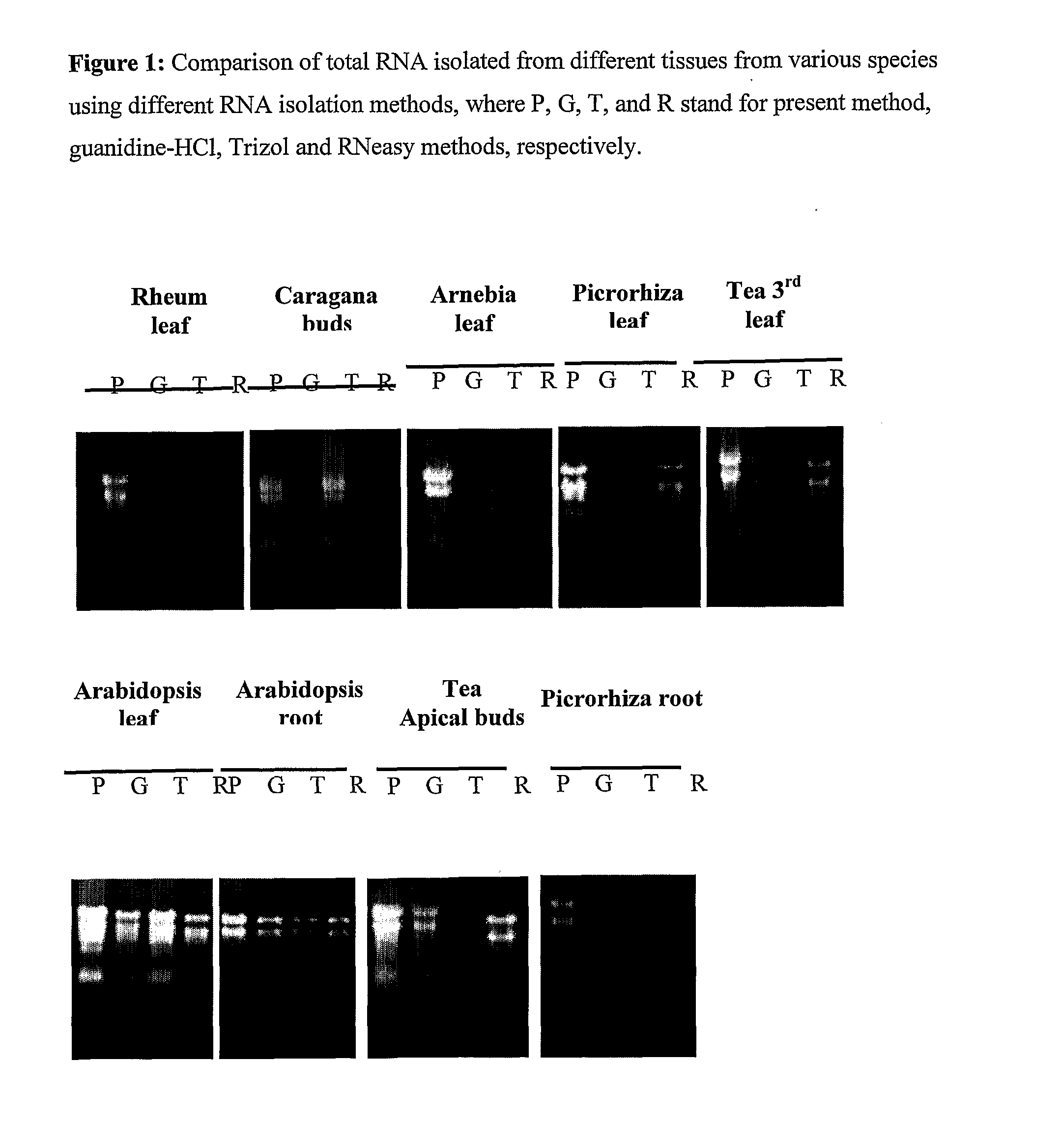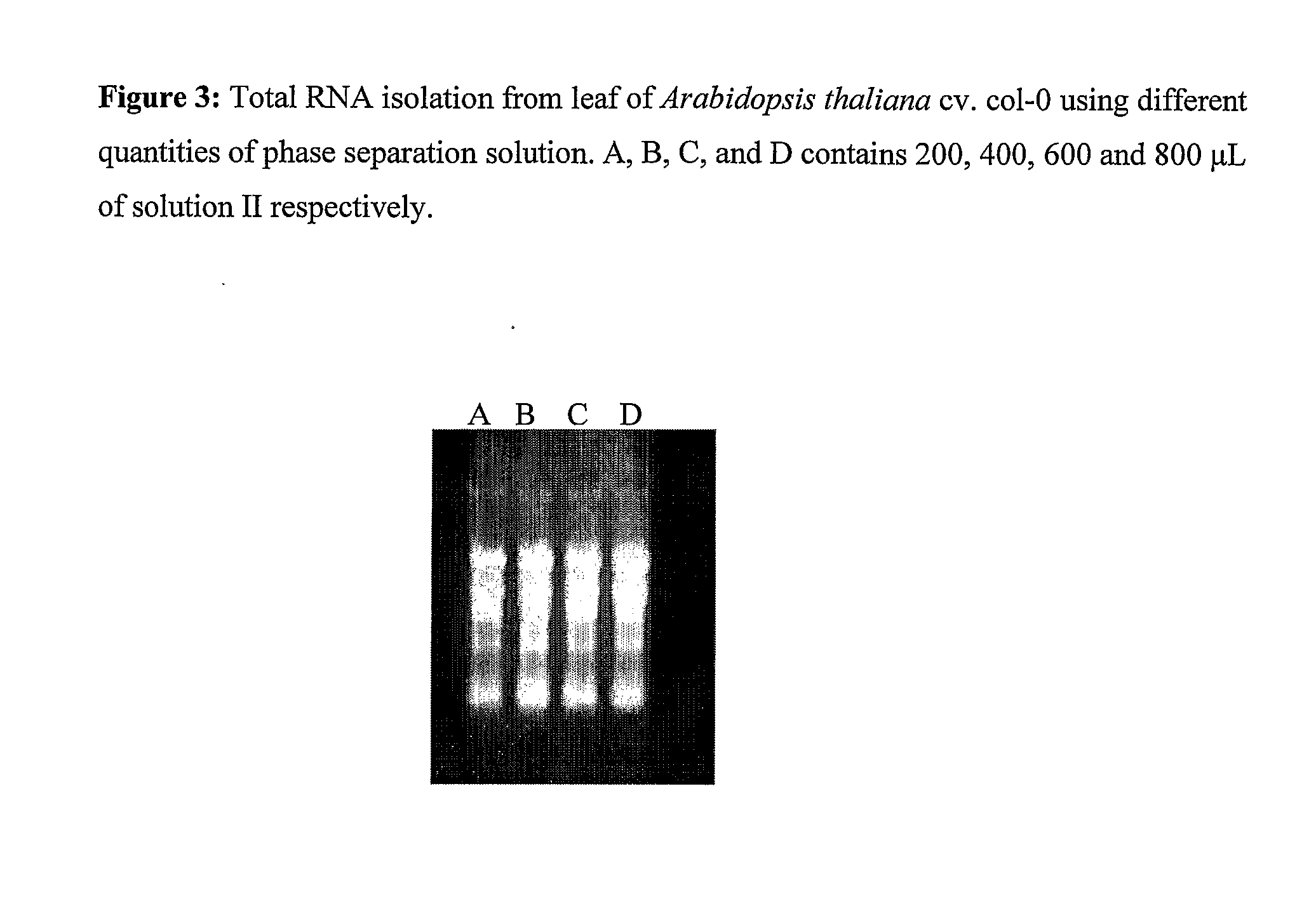Method for rapid isolation of RNA and a kit thereof
- Summary
- Abstract
- Description
- Claims
- Application Information
AI Technical Summary
Benefits of technology
Problems solved by technology
Method used
Image
Examples
example 1
Preparation of Solution for Isolation of RNA
[0070]To prepare solution I, phenol was saturated with Tris-(hydroxymethyl)-aminomethane (Tris) buffer to a pH of 6.7±0.2. Thereafter, 0.3-1% sodium dodecyl sulphate, 0.2-0.8M sodium acetate and 10-20 mM EDTA was added.
[0071]The solution II was prepared separately wherein 0.1% DEPC (final concentration) was added to deionised water having a conductivity of 17-18.2 mega-ohms. Solution was autoclaved after leaving overnight.
example 2
[0072]To isolate total RNA, the following protocol are applied:
RNA Isolation Using Guanidine Hydrochloride-Based Procedure:
[0073](Singh, G., Kumar, S, and Singh, P. 2003. A quick method to isolate RNA from wheat and other carbohydrate-rich seeds. Plant Molecular Biology Reporter 21: 93a-93f)[0074]1. Tissue (1 g) was ground in liquid nitrogen to fine powder. Powder was transferred into a new mortar containing 5 ml of the GH buffer [8 M guanidine hydrochloride, 20 mM ethylene diamine tetraacetic acid (EDTA), 20 mM MES {2-(N-morpholino)ethanesulfonic acid}, beta mercaptoethanol, 200 mM; pH 7.0] and was ground further.[0075]2. Resulting homogenate was transferred to an oak-ridge tube containing equal volume of PCI (Phenol:chloroform:isoamylalcohol).[0076]3. Phases were emulsified by vortexing and separated by centrifugation at 10,000 rpm for 20 min (7° C.).[0077]4. Upper aqueous phase was transferred to a fresh oak-ridge tube and extracted with the equal volume of CI.[0078]5. Resulting ...
example 3
[0118]The amount of solution II added to the homogenate was varied to study its effect on RNA quantity and quality. Arabidopsis thaliana leaves were used as starting material and the protocol was followed essentially as described except that 200 μl, 400 μl, 600 μl and 800 μl of solution II was added to the homogenate. It is evident from Table 2 and FIG. 3 that 800 μl of solution II yields the best results.
TABLE 3Effect of different volume of solution II on RNA yield.RNA YieldVolume of Solution II(μg / 100 mg tissue)200 μl39.8400 μl112.6600 μl116800 μl134
PUM
| Property | Measurement | Unit |
|---|---|---|
| Temperature | aaaaa | aaaaa |
| Fraction | aaaaa | aaaaa |
| Fraction | aaaaa | aaaaa |
Abstract
Description
Claims
Application Information
 Login to View More
Login to View More - R&D
- Intellectual Property
- Life Sciences
- Materials
- Tech Scout
- Unparalleled Data Quality
- Higher Quality Content
- 60% Fewer Hallucinations
Browse by: Latest US Patents, China's latest patents, Technical Efficacy Thesaurus, Application Domain, Technology Topic, Popular Technical Reports.
© 2025 PatSnap. All rights reserved.Legal|Privacy policy|Modern Slavery Act Transparency Statement|Sitemap|About US| Contact US: help@patsnap.com



